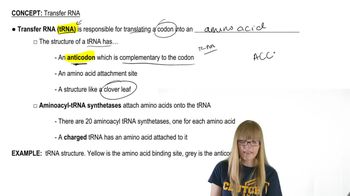Table of contents
- 1. Introduction to Genetics51m
- 2. Mendel's Laws of Inheritance3h 37m
- 3. Extensions to Mendelian Inheritance2h 41m
- 4. Genetic Mapping and Linkage2h 28m
- 5. Genetics of Bacteria and Viruses1h 21m
- 6. Chromosomal Variation1h 48m
- 7. DNA and Chromosome Structure56m
- 8. DNA Replication1h 10m
- 9. Mitosis and Meiosis1h 34m
- 10. Transcription1h 0m
- 11. Translation58m
- 12. Gene Regulation in Prokaryotes1h 19m
- 13. Gene Regulation in Eukaryotes44m
- 14. Genetic Control of Development44m
- 15. Genomes and Genomics1h 50m
- 16. Transposable Elements47m
- 17. Mutation, Repair, and Recombination1h 6m
- 18. Molecular Genetic Tools19m
- 19. Cancer Genetics29m
- 20. Quantitative Genetics1h 26m
- 21. Population Genetics50m
- 22. Evolutionary Genetics29m
11. Translation
Transfer RNA
Problem 20b
Textbook Question
Describe the roles and relationships between tRNA synthetases and tRNA molecules
 Verified step by step guidance
Verified step by step guidance1
Understand that tRNA synthetases are enzymes that play a crucial role in protein synthesis by attaching the correct amino acid to its corresponding tRNA molecule.
Recognize that each tRNA molecule has a specific anticodon that pairs with a codon on the mRNA during translation, ensuring that the correct amino acid is added to the growing polypeptide chain.
Learn that there are 20 different tRNA synthetases, one for each amino acid, and each synthetase is responsible for recognizing both the amino acid and the appropriate tRNA molecule.
Explore how tRNA synthetases catalyze the esterification of an amino acid to the 3' end of the tRNA, forming an aminoacyl-tRNA complex, which is then used in the ribosome during protein synthesis.
Consider the importance of the accuracy of tRNA synthetases in maintaining the fidelity of protein translation, as errors in amino acid attachment can lead to the incorporation of incorrect amino acids into proteins.
Recommended similar problem, with video answer:
 Verified Solution
Verified SolutionThis video solution was recommended by our tutors as helpful for the problem above
Video duration:
2mPlay a video:
Was this helpful?
Key Concepts
Here are the essential concepts you must grasp in order to answer the question correctly.
tRNA Molecules
Transfer RNA (tRNA) molecules are essential components of the protein synthesis machinery in cells. They serve as adapters that translate the genetic code from messenger RNA (mRNA) into amino acids, the building blocks of proteins. Each tRNA molecule is specific to one amino acid and has an anticodon region that pairs with the corresponding codon on the mRNA during translation.
Recommended video:
tRNA Synthetases
tRNA synthetases are a group of enzymes responsible for charging tRNA molecules with their corresponding amino acids. Each synthetase is specific to one amino acid and its associated tRNA(s), ensuring that the correct amino acid is added to the growing polypeptide chain during translation. This specificity is crucial for maintaining the fidelity of protein synthesis.
Recommended video:
Aminoacylation
Aminoacylation is the process by which tRNA synthetases attach an amino acid to its corresponding tRNA, forming an aminoacyl-tRNA complex. This reaction is vital for accurate translation, as it ensures that the correct amino acid is delivered to the ribosome according to the mRNA sequence. The energy for this reaction comes from ATP, which is hydrolyzed to AMP and pyrophosphate.
Recommended video:
Related Videos
Related Practice




